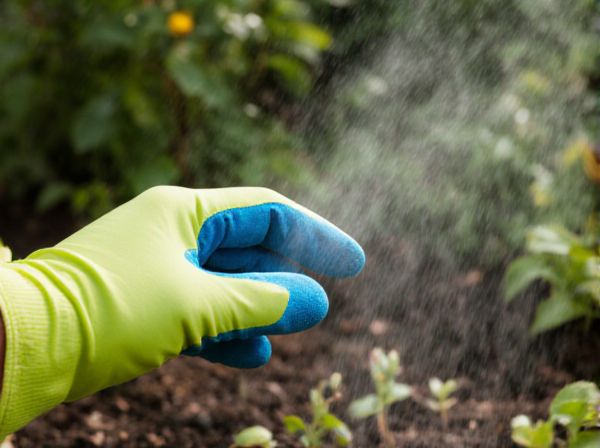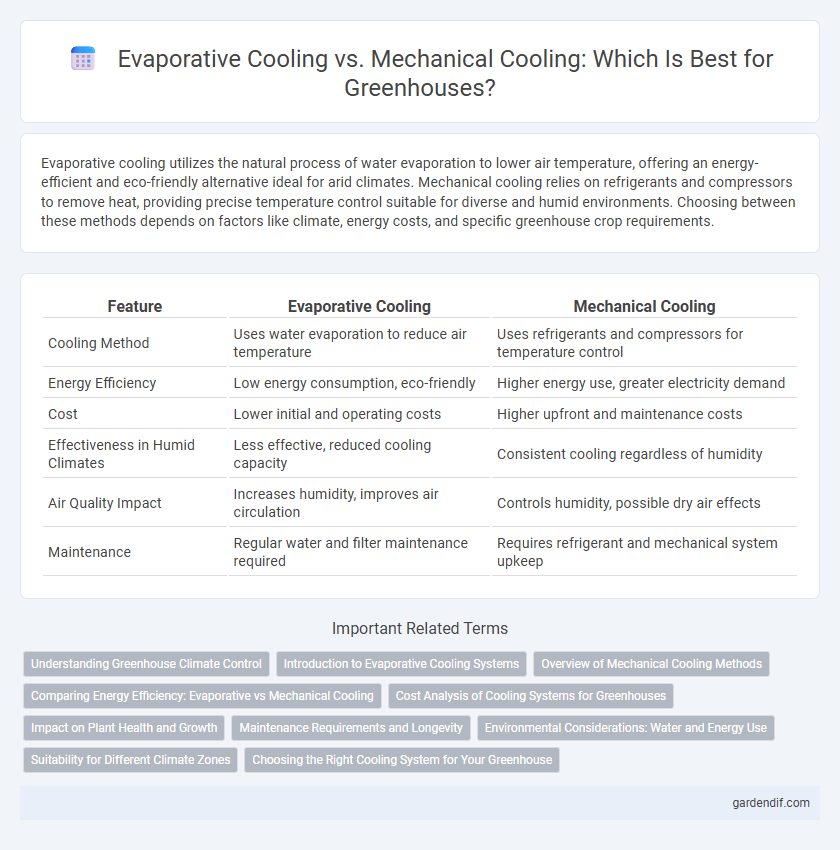
Evaporative Cooling vs Mechanical Cooling Illustration
Evaporative cooling utilizes the natural process of water evaporation to lower air temperature, offering an energy-efficient and eco-friendly alternative ideal for arid climates. Mechanical cooling relies on refrigerants and compressors to remove heat, providing precise temperature control suitable for diverse and humid environments. Choosing between these methods depends on factors like climate, energy costs, and specific greenhouse crop requirements.
Table of Comparison
| Feature | Evaporative Cooling | Mechanical Cooling |
|---|---|---|
| Cooling Method | Uses water evaporation to reduce air temperature | Uses refrigerants and compressors for temperature control |
| Energy Efficiency | Low energy consumption, eco-friendly | Higher energy use, greater electricity demand |
| Cost | Lower initial and operating costs | Higher upfront and maintenance costs |
| Effectiveness in Humid Climates | Less effective, reduced cooling capacity | Consistent cooling regardless of humidity |
| Air Quality Impact | Increases humidity, improves air circulation | Controls humidity, possible dry air effects |
| Maintenance | Regular water and filter maintenance required | Requires refrigerant and mechanical system upkeep |
Understanding Greenhouse Climate Control
Evaporative cooling in greenhouses utilizes the natural process of water evaporation to lower air temperature and increase humidity, enhancing plant growth while reducing energy consumption. Mechanical cooling employs refrigeration-based systems to regulate temperature more precisely but often at higher operational costs and energy use. Effective greenhouse climate control balances these methods to optimize temperature, humidity, and ventilation, ensuring ideal conditions for crop productivity.
Introduction to Evaporative Cooling Systems
Evaporative cooling systems harness the natural process of water evaporation to lower greenhouse temperatures, offering energy-efficient climate control compared to mechanical cooling. These systems utilize wet pads or misting to increase humidity and reduce air temperature, maximizing plant growth conditions while minimizing electricity consumption. Evaporative cooling is particularly effective in arid climates where moisture evaporation significantly cools incoming air.
Overview of Mechanical Cooling Methods
Mechanical cooling methods in greenhouses primarily involve refrigeration cycles, including vapor-compression systems and absorption cooling, to maintain optimal temperatures. These systems use compressors, condensers, and evaporators to remove heat efficiently from the greenhouse environment, offering precise temperature control. Mechanical cooling is especially effective in regions with high humidity where evaporative cooling's efficiency is limited.
Comparing Energy Efficiency: Evaporative vs Mechanical Cooling
Evaporative cooling systems in greenhouses typically consume 50-70% less energy than mechanical cooling methods, leveraging natural water evaporation to reduce temperatures efficiently. Mechanical cooling relies on compressors and refrigerants, leading to higher electricity consumption and increased operational costs. Selecting evaporative cooling optimizes energy efficiency while enhancing sustainability in controlled-environment agriculture.
Cost Analysis of Cooling Systems for Greenhouses
Evaporative cooling systems for greenhouses generally offer lower initial installation and operating costs due to their simpler technology and reduced energy consumption compared to mechanical cooling systems. Mechanical cooling requires higher capital investment and ongoing expenses for compressors, refrigerants, and electricity, significantly impacting long-term operational budgets. For energy-efficient greenhouse management, analyzing factors such as climate, size, and cooling load is essential to determine the most cost-effective system.
Impact on Plant Health and Growth
Evaporative cooling lowers greenhouse temperatures by increasing humidity and promoting natural transpiration, which enhances plant physiological processes and reduces water stress. Mechanical cooling offers precise temperature control but can decrease humidity, potentially causing plant dehydration and stomatal closure, which limits photosynthesis. Optimal plant health and growth often depend on balancing temperature regulation with humidification, favoring evaporative cooling in arid climates and mechanical systems where strict temperature control is essential.
Maintenance Requirements and Longevity
Evaporative cooling systems in greenhouses require regular maintenance such as cleaning pads and water reservoirs to prevent algae buildup and ensure efficient airflow, with components typically lasting 5-10 years. Mechanical cooling systems, including compressors and refrigerants, demand more frequent and specialized maintenance like refrigerant checks and coil cleaning, often resulting in higher operational costs but with a lifespan of 10-15 years if properly serviced. Choosing between the two depends on balancing the lower maintenance intensity and shorter lifespan of evaporative systems against the higher maintenance demands and extended durability of mechanical cooling.
Environmental Considerations: Water and Energy Use
Evaporative cooling in greenhouses uses significantly less energy than mechanical cooling systems, reducing the carbon footprint associated with temperature control. This method relies on water evaporation, which can increase water consumption, making efficient water management critical. Mechanical cooling, while typically consuming more electricity, conserves water but may contribute to higher greenhouse gas emissions depending on the energy source.
Suitability for Different Climate Zones
Evaporative cooling is highly effective in dry, arid climates where humidity levels are low, maximizing moisture evaporation to reduce greenhouse temperatures efficiently. Mechanical cooling systems perform better in hot, humid regions by actively controlling temperature and humidity, ensuring optimal plant growth conditions. Selecting the appropriate cooling method depends on climate-specific factors such as ambient humidity, temperature fluctuations, and energy availability.
Choosing the Right Cooling System for Your Greenhouse
Selecting the right cooling system for your greenhouse depends on factors like climate, budget, and plant requirements. Evaporative cooling systems, ideal for dry climates, use water evaporation to lower temperatures efficiently while conserving energy. Mechanical cooling systems, such as air conditioners, provide precise temperature control and humidity management but involve higher operational costs and power consumption.
Evaporative Cooling vs Mechanical Cooling Infographic

 gardendif.com
gardendif.com